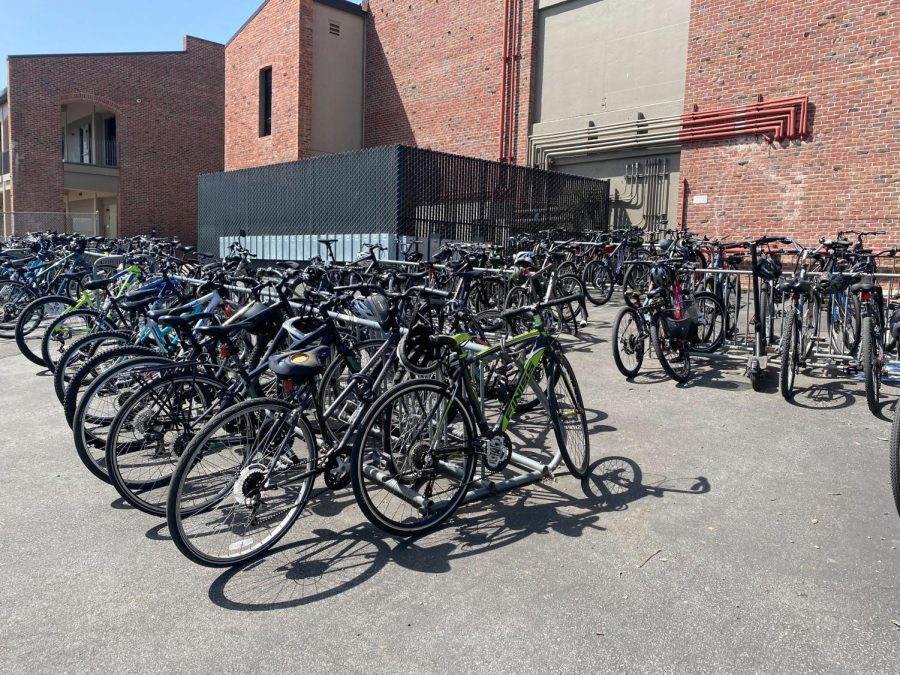Combating air pollution
Exploring steps students and administrators are taking to reduce MVHS’s carbon footprint
Students leave their bikes at the bike racks.
April 19, 2022
Air pollution is not seen as a big problem in Cupertino — with an average air quality index of 40 in the past month, which is within the ideal levels of 0-50, the city is categorized as “Good” in terms of the levels of ozone, the main pollutant in the atmosphere.
However, this does not mean that MVHS doesn’t contribute to air pollution. About 61% of students and staff travel to and from school in a family vehicle, releasing pollutants into the air. Because of this, Cupertino is trying to encourage students to bike, walk and carpool to school.
Roy Chan is a Partner Success Principal at Via, a rideshare app that has partnered with the City of Cupertino, and says it’s a Cupertino-specific version of other rideshare apps such as Uber and Lyft. He explains that Via-Cupertino is an option that “allows riders to carpool together” as “a way to cut down on greenhouse gas emissions.”
In addition, Via-Cupertino provides discounted two dollar rides around the city to students who have verified that they are a student using their name, phone number and student ID by email to the Via-Cupertino Shuttle. Via-Cupertino has nine vans, with two of them being wheelchair accessible, and all containing bike racks, and this service can be utilized by anyone to travel within the borders of the city — all the user needs to do is download the Via app, book a ride and once a driver is connected to them, they will be picked up within five to 10 minutes.
“[We’ve had] about 300 rides from students in the last couple of months and we want to make sure that students know about the service we’ve gotten [and we] definitely want to hear the feedback [from] any students who have tried the service,” Chan said. “We started talking to the Safe Routes to School team, because they’re doing walking [and] biking. We’re all just working together to look for ways to reduce the carbon footprint.”
Junior Kelly Tung, who serves as one of the MVHS student representatives for Cupertino Safe Routes to School, describes SR2S as a city-led organization that works towards creating more efficient and safer routes for students traveling to and from schools. By promoting biker and pedestrian safety, Tung notes that SR2S encourages more students to move away from the “driv[ing] and car-related culture.”

Tung notices that although students’ and staff’s mode of transportation greatly contributes to MVHS’s overall carbon footprint, they can’t be blamed for the negative consequences of driving because they are not “purposefully generating a lot [of greenhouse gasses].” She says that driving to and from school is the only mode of transport that many students can use because they live beyond walking and biking distances.
Tung finds this to be a relatable struggle since it takes her about 25 minutes to walk to school. Even though she wants to reduce her carbon footprint, she has to rely on driving when she has meetings after school or when the weather is not suitable. While her parents sometimes drive her, Tung also utilizes Via, which she finds to be accessible and easy to use.
Apart from reducing air pollution, students also have other motivations for biking and walking to school, such as socializing and becoming more independent, according to sophomore Koren Gila. He has been biking to school since fourth grade — once his parents thought that he was old enough to commute to school by himself — because he finds it to be more convenient than having his parents drive him to school every day. His routine includes biking to his friend’s house first and then biking to school together, which Gila describes as an enjoyable part of his morning.
“I think that more people should try [biking to school] because people think, ‘Oh, you have to wake up so much earlier,’ but it’s not that bad,” Gila said. “So people should try it and then see because if they like it, then they should do it. It’s healthier, and you get to be outside more [and] if you are going with your friends, you get to socialize.”
Though Tung believes that the school has been trying to promote biking and walking to school, Gila notes that incentives such as Bike for Boba, organized by SR2S, may have the intention to promote biking to school, but finds that the prolonged wait time to get a boba drink and the short-lived success of the event outweighs the benefits. Additionally, he believes that it made no change to the number of people who bike regularly, and in order for it to have a significant impact on air pollution, the incentive needs to have a long-term impact.
Tung acknowledges that the effort of implementing changes should fit the needs of the community. She also hopes that public transportation will be more accessible in Cupertino in the future, as another way air pollution can be reduced.
“I really wish that we had a form of transportation like the VTA [public transit] that is more accessible to people because if we did, then they wouldn’t have to resort to driving,” Tung said. “I [also] wish that we could pass more infrastructure that allows people to walk to school safely. Cupertino has definitely made tangible efforts in encouraging our students and our residents to be more active while maintaining the safety of our community and I just hope to continue seeing further advocacy and further action taken to maintain that.”

















